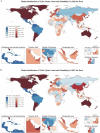Global burden and future projections of geriatric gout (1990-2021): a comprehensive analysis and Bayesian Age-Period-Cohort modeling
- PMID: 40376055
- PMCID: PMC12078167
- DOI: 10.3389/fpubh.2025.1577265
Global burden and future projections of geriatric gout (1990-2021): a comprehensive analysis and Bayesian Age-Period-Cohort modeling
Abstract
Introduction: Gout is increasingly recognized as a major chronic condition among older adults, contributing significantly to global disease burden, healthcare costs, and disability.
Methods: This study utilized data from the Global Burden of Disease (GBD) database, covering 204 countries and regions from 1990 to 2021. We evaluated age-standardized incidence rates, prevalence, and Years Lived with Disability (YLDs) of gout among individuals aged 60 years and older. Inequality and frontier analyses were conducted to explore disparities, and Bayesian Age-Period-Cohort (BAPC) models were applied for future trend projections up to 2036.
Results: All indicators-incidence, prevalence, and YLDs-showed a steady increase across the study period, with particularly rapid growth observed in high Socio-demographic Index (SDI) regions and among older women. Although the burden was concentrated in high SDI countries, increasing trends were also evident in low SDI areas. Significant heterogeneity was found among countries with similar SDI levels.
Discussion: The projected rise in gout burden through 2036 underscores the urgent need for targeted public health strategies. Disparities across SDI groups suggest that medical infrastructure, prevention programs, and cultural contexts play critical roles in disease control. Comprehensive interventions are essential to manage this growing challenge, especially among high-risk older populations.
Keywords: BAPC analysis; GBD; YLDs rate; gout; older adult population.
Copyright © 2025 Wang, Zhao, Zhao and Zhang.
Conflict of interest statement
The authors declare that the research was conducted in the absence of any commercial or financial relationships that could be construed as a potential conflict of interest.
Figures






Similar articles
-
Global, regional and national temporal trends in Parkinson's disease incidence, disability-adjusted life year rates in middle-aged and older adults: a cross-national inequality analysis and Bayesian age-period-cohort analysis based on the global burden of disease 2021.Neurol Sci. 2025 Apr;46(4):1647-1660. doi: 10.1007/s10072-024-07941-7. Epub 2024 Dec 14. Neurol Sci. 2025. PMID: 39673044
-
Spatiotemporal trends in hernia disease burden and health workforce correlations in aging populations: a global analysis with projections to 2050.BMC Gastroenterol. 2025 Apr 25;25(1):296. doi: 10.1186/s12876-025-03916-w. BMC Gastroenterol. 2025. PMID: 40281398 Free PMC article.
-
Global, regional, and national burden of fracture of sternum and/or fracture of one or more ribs: a systematic analysis of incidence, YLDs with projections to 2030.Front Public Health. 2025 Apr 3;13:1565478. doi: 10.3389/fpubh.2025.1565478. eCollection 2025. Front Public Health. 2025. PMID: 40247872 Free PMC article.
-
Global, regional, and national burden of fracture of vertebral column, 1990-2021: analysis of data from the global burden of disease study 2021.Front Public Health. 2025 Apr 30;13:1573888. doi: 10.3389/fpubh.2025.1573888. eCollection 2025. Front Public Health. 2025. PMID: 40371297 Free PMC article.
-
Global, regional, and national burden of asthma and atopic dermatitis, 1990-2021, and projections to 2050: a systematic analysis of the Global Burden of Disease Study 2021.Lancet Respir Med. 2025 May;13(5):425-446. doi: 10.1016/S2213-2600(25)00003-7. Epub 2025 Mar 24. Lancet Respir Med. 2025. PMID: 40147466
References
-
- Yanai H, Adachi H, Hakoshima M, Katsuyama H. Molecular biological and clinical understanding of the pathophysiology and treatments of hyperuricemia and its association with metabolic syndrome, cardiovascular diseases and chronic kidney disease. Int J Mol Sci. (2021) 22:9221. doi: 10.3390/ijms22179221, PMID: - DOI - PMC - PubMed
MeSH terms
LinkOut - more resources
Full Text Sources
Medical

